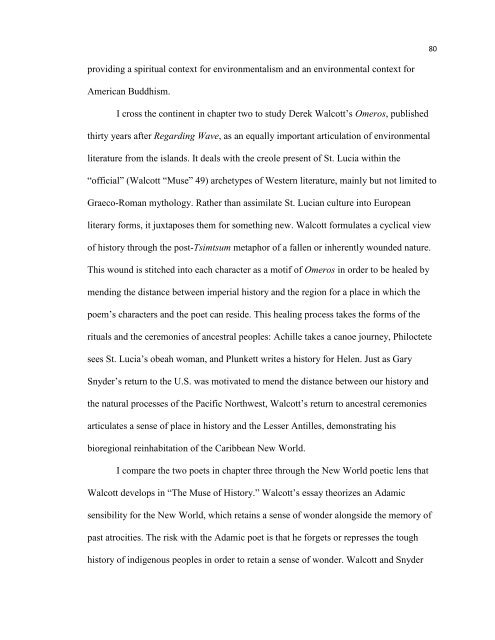RE-INHABITING THE ISLANDS - The University of North Carolina at ...
RE-INHABITING THE ISLANDS - The University of North Carolina at ...
RE-INHABITING THE ISLANDS - The University of North Carolina at ...
You also want an ePaper? Increase the reach of your titles
YUMPU automatically turns print PDFs into web optimized ePapers that Google loves.
80<br />
providing a spiritual context for environmentalism and an environmental context for<br />
American Buddhism.<br />
I cross the continent in chapter two to study Derek Walcott‘s Omeros, published<br />
thirty years after Regarding Wave, as an equally important articul<strong>at</strong>ion <strong>of</strong> environmental<br />
liter<strong>at</strong>ure from the islands. It deals with the creole present <strong>of</strong> St. Lucia within the<br />
―<strong>of</strong>ficial‖ (Walcott ―Muse‖ 49) archetypes <strong>of</strong> Western liter<strong>at</strong>ure, mainly but not limited to<br />
Graeco-Roman mythology. R<strong>at</strong>her than assimil<strong>at</strong>e St. Lucian culture into European<br />
literary forms, it juxtaposes them for something new. Walcott formul<strong>at</strong>es a cyclical view<br />
<strong>of</strong> history through the post-Tsimtsum metaphor <strong>of</strong> a fallen or inherently wounded n<strong>at</strong>ure.<br />
This wound is stitched into each character as a motif <strong>of</strong> Omeros in order to be healed by<br />
mending the distance between imperial history and the region for a place in which the<br />
poem‘s characters and the poet can reside. This healing process takes the forms <strong>of</strong> the<br />
rituals and the ceremonies <strong>of</strong> ancestral peoples: Achille takes a canoe journey, Philoctete<br />
sees St. Lucia‘s obeah woman, and Plunkett writes a history for Helen. Just as Gary<br />
Snyder‘s return to the U.S. was motiv<strong>at</strong>ed to mend the distance between our history and<br />
the n<strong>at</strong>ural processes <strong>of</strong> the Pacific <strong>North</strong>west, Walcott‘s return to ancestral ceremonies<br />
articul<strong>at</strong>es a sense <strong>of</strong> place in history and the Lesser Antilles, demonstr<strong>at</strong>ing his<br />
bioregional reinhabit<strong>at</strong>ion <strong>of</strong> the Caribbean New World.<br />
I compare the two poets in chapter three through the New World poetic lens th<strong>at</strong><br />
Walcott develops in ―<strong>The</strong> Muse <strong>of</strong> History.‖ Walcott‘s essay theorizes an Adamic<br />
sensibility for the New World, which retains a sense <strong>of</strong> wonder alongside the memory <strong>of</strong><br />
past <strong>at</strong>rocities. <strong>The</strong> risk with the Adamic poet is th<strong>at</strong> he forgets or represses the tough<br />
history <strong>of</strong> indigenous peoples in order to retain a sense <strong>of</strong> wonder. Walcott and Snyder
















